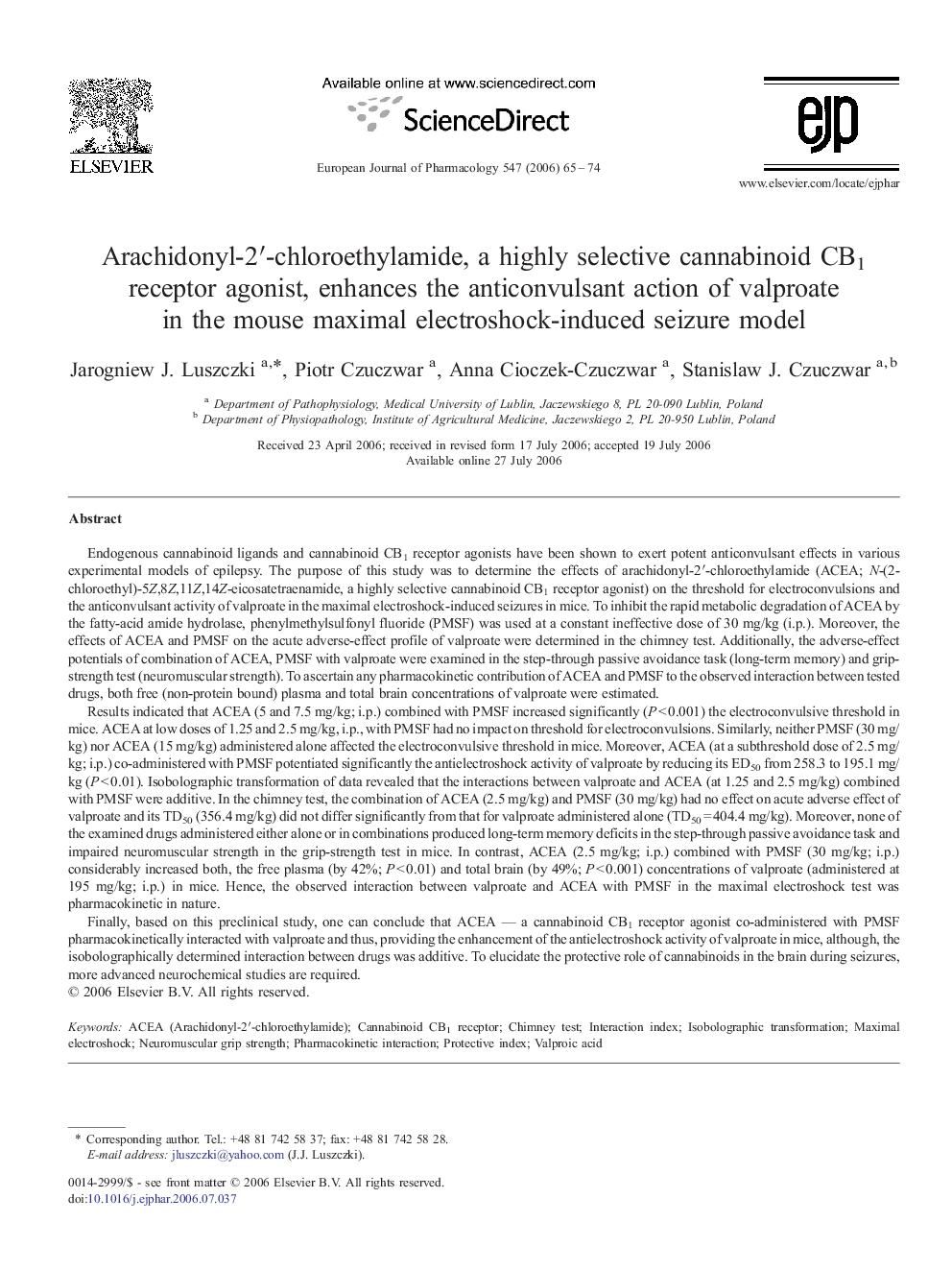| کد مقاله | کد نشریه | سال انتشار | مقاله انگلیسی | نسخه تمام متن |
|---|---|---|---|---|
| 2536848 | 1559168 | 2006 | 10 صفحه PDF | دانلود رایگان |

Endogenous cannabinoid ligands and cannabinoid CB1 receptor agonists have been shown to exert potent anticonvulsant effects in various experimental models of epilepsy. The purpose of this study was to determine the effects of arachidonyl-2′-chloroethylamide (ACEA; N-(2-chloroethyl)-5Z,8Z,11Z,14Z-eicosatetraenamide, a highly selective cannabinoid CB1 receptor agonist) on the threshold for electroconvulsions and the anticonvulsant activity of valproate in the maximal electroshock-induced seizures in mice. To inhibit the rapid metabolic degradation of ACEA by the fatty-acid amide hydrolase, phenylmethylsulfonyl fluoride (PMSF) was used at a constant ineffective dose of 30 mg/kg (i.p.). Moreover, the effects of ACEA and PMSF on the acute adverse-effect profile of valproate were determined in the chimney test. Additionally, the adverse-effect potentials of combination of ACEA, PMSF with valproate were examined in the step-through passive avoidance task (long-term memory) and grip-strength test (neuromuscular strength). To ascertain any pharmacokinetic contribution of ACEA and PMSF to the observed interaction between tested drugs, both free (non-protein bound) plasma and total brain concentrations of valproate were estimated.Results indicated that ACEA (5 and 7.5 mg/kg; i.p.) combined with PMSF increased significantly (P < 0.001) the electroconvulsive threshold in mice. ACEA at low doses of 1.25 and 2.5 mg/kg, i.p., with PMSF had no impact on threshold for electroconvulsions. Similarly, neither PMSF (30 mg/kg) nor ACEA (15 mg/kg) administered alone affected the electroconvulsive threshold in mice. Moreover, ACEA (at a subthreshold dose of 2.5 mg/kg; i.p.) co-administered with PMSF potentiated significantly the antielectroshock activity of valproate by reducing its ED50 from 258.3 to 195.1 mg/kg (P < 0.01). Isobolographic transformation of data revealed that the interactions between valproate and ACEA (at 1.25 and 2.5 mg/kg) combined with PMSF were additive. In the chimney test, the combination of ACEA (2.5 mg/kg) and PMSF (30 mg/kg) had no effect on acute adverse effect of valproate and its TD50 (356.4 mg/kg) did not differ significantly from that for valproate administered alone (TD50 = 404.4 mg/kg). Moreover, none of the examined drugs administered either alone or in combinations produced long-term memory deficits in the step-through passive avoidance task and impaired neuromuscular strength in the grip-strength test in mice. In contrast, ACEA (2.5 mg/kg; i.p.) combined with PMSF (30 mg/kg; i.p.) considerably increased both, the free plasma (by 42%; P < 0.01) and total brain (by 49%; P < 0.001) concentrations of valproate (administered at 195 mg/kg; i.p.) in mice. Hence, the observed interaction between valproate and ACEA with PMSF in the maximal electroshock test was pharmacokinetic in nature.Finally, based on this preclinical study, one can conclude that ACEA — a cannabinoid CB1 receptor agonist co-administered with PMSF pharmacokinetically interacted with valproate and thus, providing the enhancement of the antielectroshock activity of valproate in mice, although, the isobolographically determined interaction between drugs was additive. To elucidate the protective role of cannabinoids in the brain during seizures, more advanced neurochemical studies are required.
Journal: European Journal of Pharmacology - Volume 547, Issues 1–3, 10 October 2006, Pages 65–74